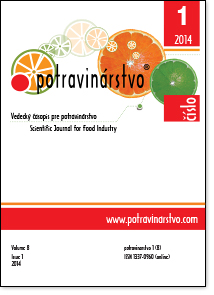Evaluation of Model Wheat/Hemp Composites
DOI:
https://doi.org/10.5219/317Keywords:
wheat-hemp composite flour, protein content and quality, SRC profile, correlation analysisAbstract
Model cereal blends were prepared from commercial wheat fine flour and 5 samples of hemp flour (HF), including fine (2 of conventional form, 1 of organic form) and wholemeal type (2 of conventional form). Wheat flour was substituted in 4 levels (5, 10, 15, 20%). HF addition has increased protein content independently on tested hemp flour form or type. Partial model cereal blends could be distinguished according to protein quality (Zeleny test values), especially between fine and wholemeal HF type. Both flour types affected also amylolytic activity, for which a relationship between hemp addition and determined level of Falling Number was confirmed for all five model cereal blends. Solvent retention capacity profiles (SRC) of partial models were influenced by both HF form and type, as well as by its addition level. Between both mentioned groups of quality features, significant correlation were proved - relationships among protein content/quality and lactic acid SRC were verifiable on p <0.01 (-0.58, 0.91, respectively). By performed ANOVA, a possibility to distinguish the HF form used in model cereal blend according to the lactic acid SRC and the water SRC was demonstrated. Comparing partial cereal models containing fine and wholemeal hemp type, HF addition level demonstrated its impact on the sodium carbonate SRC and the water acid SRC.
Downloads
Metrics
References
AACC Method 56-11. Solvent retention capacity profile. In: Approved methods of the American Association of Cereal Chemists. 10th ed. St. Paul: The American Association of Cereal Chemists, 2000. ISBN 1891127128.
Callaway, J. C., 2004. Hempseed as a nutritional resource: An overview. Euphytica, vol. 140, no. 1-2, p. 65-72. https://doi.org/10.1007/s10681-004-4811-6 DOI: https://doi.org/10.1007/s10681-004-4811-6
ČSN ISO 1871. Food and feed products - General guidelines for the determination of nitrogen by the Kjeldahl method. Praha: Czech Office for Standards, Metrology and Testing ÚNMZ, 2010. 5 p.
ČSN ISO 5529. Wheat - Determination of the sedimentation index - Zeleny test. Praha: Czech Office for Standards, Metrology and Testing ÚNMZ, 2011. 9 p.
ČSN ISO 3039. Determination of the falling number according to Hagberg-Perten. Praha: Czech Office for Standards, Metrology and Testing ÚNMZ, 2011. 8 p.
Duyvejonck, A. E., Lagrain, B., Pareyt, B., Courtin, C. M., Delcour, J. A., 2011. Relative contribution of wheat flour constituents to Solvent Retention Capacity profiles of European wheats. Journal of Cereal Science, vol. 53, p. 312-318. https://doi.org/10.1016/j.jcs.2011.01.014 DOI: https://doi.org/10.1016/j.jcs.2011.01.014
Gaines, C. S., 2000. Report of the AACC committee on soft wheat flour. Method 56-11. Solvent Retention Capacity Profile. Cereal Foods World, vol. 45, p. 303-306.
Guttieri, M. J., Souza, E., 2003. Sources of variation in the Solvent Retention Capacity test of wheat flour. Crop Science, vol. 43, p. 1628-1633. https://doi.org/10.2135/cropsci2003.1628 DOI: https://doi.org/10.2135/cropsci2003.1628
Hrušková, M., Karas, J., Švec, I., 2010. Retenční kapacita - příklad užití pro hodnocení ve mlýně (Solvent Retention Capacity - usage example for quality evaluation in a commercial mill). Mlynářské noviny, vol. 4, p. 10-12. [In Czech]
Hrušková, M., Hofmanová, T., Švec, I., 2011. Hodnocení vybraných druhů kompozitní mouky (Evaluation of selected types of composite flour). Mlynářské noviny, vol. 2, p. 10-12. [In Czech]
Kweon, M., Slade, L., Levine, H., 2011. Solvent retention capacity (SRC) testing of wheat flour: Principles and value in predicting flour functionality in different wheat-based food processes and in wheat breeding. A review. Cereal Chemistry, vol. 88, no. 6, p. 537-552. https://doi.org/10.1094/CCHEM-07-11-0092 DOI: https://doi.org/10.1094/CCHEM-07-11-0092
Oliete, B., Pérez, G. T., Gómez, M., Ribotta, P. D., Moiraghi, M., León, A. E., 2010. Use of wheat, triticale and rye flours in layer cake production. International Journal of Food Science and Technology, vol. 45, no. 4, p. 697-706. https://doi.org/10.1111/j.1365-2621.2010.02183.x DOI: https://doi.org/10.1111/j.1365-2621.2010.02183.x
Rosell, C. M., Santos, E., Collar, C., 2009. Physico-chemical properties of commercial fibres from different sources: A comparative approach. Food Research International, vol. 42, no. 1, p. 176-184. https://doi.org/10.1016/j.foodres.2008.10.003 DOI: https://doi.org/10.1016/j.foodres.2008.10.003
Xiao, Z. S., Park, S. H., Chung, O. K., Caley, M. S., Seib, P. A., 2006. Solvent retention capacity values in relation to hard winter wheat and flour properties and straight-dough breadmaking quality. Cereal Chemistry, vol. 83, no. 5, p. 465-471. https://doi.org/10.1094/CC-83-0465 DOI: https://doi.org/10.1094/CC-83-0465
Downloads
Published
How to Cite
Issue
Section
License
This license permits non-commercial re-use, distribution, and reproduction in any medium, provided the original work is properly cited, and is not altered, transformed, or built upon in any way.






























